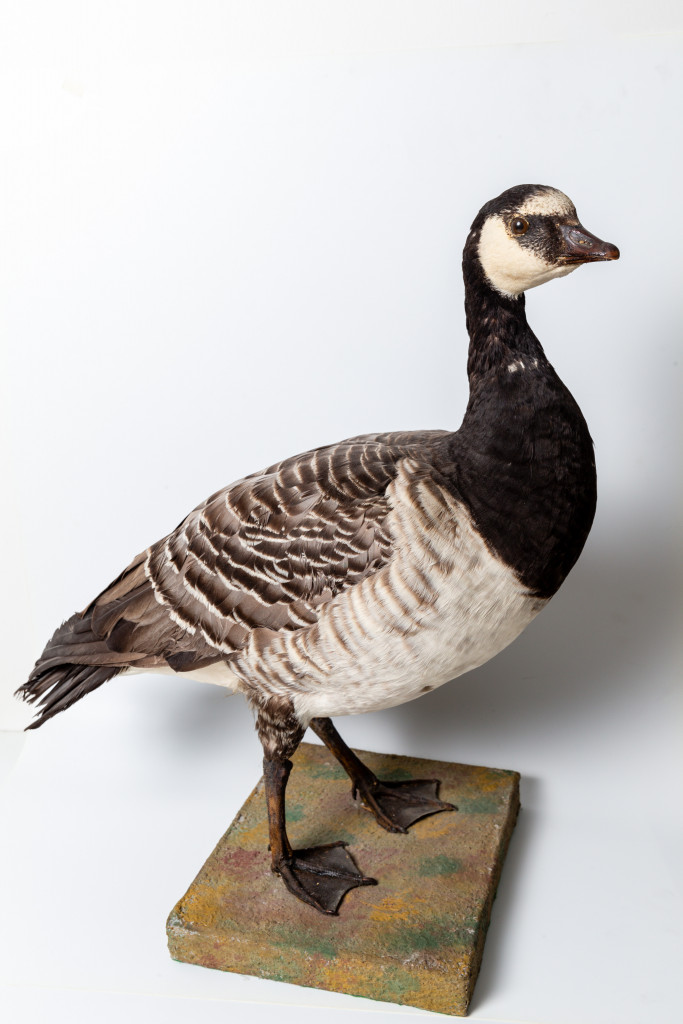Waiting 50 Years to be Told
Enlarge

By Joel G. Jorgensen
The Nebraska Game and Parks Commission occasionally receives animal mounts from individuals who want or need to unload them but do not want to see them go straight to the garbage bin. These donations, if in acceptable condition, can be used for education or to spruce up a public space. Usually the mounts the agency receives possess little or no information about where the animal was harvested or collected, as most are decades old. This was the case for an unusual goose mount that has been in the Lincoln Headquarters for quite some time. In fact, it is not known how or when the specimen got here, but it sat quietly in our building for at least 15 years waiting to tell its story.
It was not until I was looking up some old information in the state’s ornithological journal, The Nebraska Bird Review, when I realized a photograph of a purported barnacle goose harvested in Otoe County in November 1968 by Milton Muncie appeared rather similar to our “goosey” office decor. Upon closer inspection, it was confirmed the bird in the photograph and the mount in the office were one and the same.
Barnacle geese are a Eurasian species and, at the time, Muncie’s prize was reported as a Nebraska first. However, records of barnacle geese in North America before the early 2000s were generally dismissed as representing escaped domestic birds because the species is also kept in captivity in North America. This conclusion has been shown to be incorrect as wild barnacle geese that nest in Greenland do, on occasion, reach North America. So, is it safe to conclude the Nebraska specimen is a wild bird? Not necessarily, but possessing its feathers provides the opportunity to find out.
Feathers are composed of keratin and are a product of the environment in which they were produced. This means some atoms and molecules a bird ingests through its diet will ultimately be preserved in feathers a bird grows at specific times. Keratin does not change or break down over time, and certain atoms, specifically isotopes, vary with weather conditions. Stable isotope analysis is a technique where a feather’s signature can be matched to certain areas of the world. In this case, a northerly signature would suggest a wild bird and a temperate signature would suggest an escaped captive bird. Long story short, stable isotope analysis showed that this bird grew its feathers at the northern location in Canada or Greenland, thus suggesting a wild bird.
Is this the end of the story? There is one final twist. Upon review, it was determined this “barnacle goose” was, in fact, a hybrid. Making absolute conclusions about parent species of avian hybrids can be a risky venture, but plumage characteristics suggest this goose is a barnacle/cackling goose hybrid, with the latter species previously known as the small form of the Canada goose. Interestingly, the goose was harvested in a flock of Arctic-breeding cackling geese, or hutchies, as they are sometimes called. As cackling geese are rarely — if ever — kept as exotic pets in North America, the case for a wild origin of this hybrid bird only grew stronger.
Nebraska has no other accepted records of barnacle geese, but the evidence this bird possessed in its feathers shows wild birds are capable of migrating to our state. It is a story that was just waiting 50 years to be told. A more complete summary of this study is presented in the latest edition of The Nebraska Bird Review. ■
Joel G. Jorgensen is the nongame bird program manager for the Nebraska Game and Parks Commission.
The post Mystery Goose Mount appeared first on Nebraskaland Magazine.
















